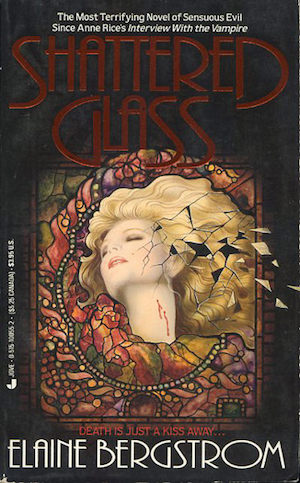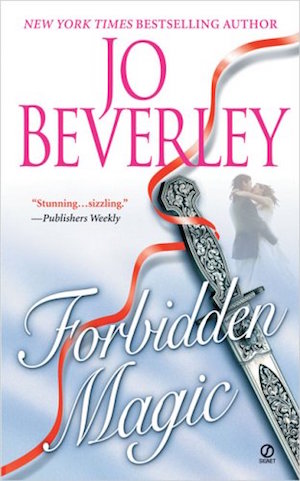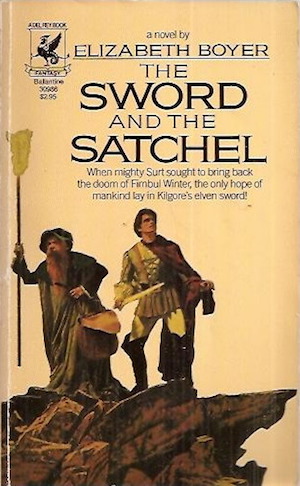Let us journey onward, this time to women who first published speculative fiction in the 1980s whose surnames begin with B. There are no small number. (And of course you can find the previous installment covering names beginning with A here, while the entire series of articles on the 1970s as well as the ‘80s are collected here.)
Nancy Baker

Canadian Nancy Baker has been publishing dark fantasy since the late 1980s. She has published four novels so far (and a fifth is coming out soon). Readers new to Baker might want to sample her 1993 The Night Inside (also published as The Kiss of the Vampire), in which grad student Ardeth Alexander is targeted by a vampire.
Virginia Baker

Although active since the 1980s, Virginia Baker appears to have published just one novel thus far: 2007’s Jack Knife, in which the effort to catch the killer responsible for the Ripper murders is complicated by two time travellers.
Cherith Baldry

British teacher Cherith Baldry is moderately prolific under her own name; she also publishes under a number of house names (Adam Blade, Jenny Dale, Jack Dillon, and Erin Hunter). If interested in her YA material, readers might try the anthropomorphic adventure The Silver Horn, or perhaps one of the Warriors novels published under the shared pen-name Erin Hunter. Unfortunately I am a bit unclear how the authors sharing that name (Kate Cary, Cherith Baldry, Tui Sutherland, and several others) manage the workload. Do they all collaborate on each book or are different instalments written by a specific author? Feel free to provide more information in comments!
Wendy Barish

Wendy Barish’s output seems to be limited to two works, both written with the late William Rotsler: the 1984 collection Star Trek III: Short Stories and the choose-your-own-adventure Star Trek III: The Vulcan Treasure. Do I need to explain the choose-your-own-adventure genre? Basically, imagine a solitaire adventure game where the decision tree is presented as different alternates at the end of short text pieces. They were very popular back in the day, but I’d imagine computer games came along and ate their lunch.
Hillary Bartholomew
Semi-retired teacher Hillary Bartholomew is most active in speculative fiction as a poet, which I admit is a blind spot of mine.
Lee Barwood

Lee Barwood contributed to the Liavek shared-world project edited by Emma Bull and Will Shetterly. Much of her work appears to have an ecological bent, as demonstrated by her novel A Dream of Drowned Hollow, in which a magic-rich backwater valley is threatened by profit-hungry developers.
Gael Baudino

Gaèl Baudino writes under her own name as well as a number of pseudonyms. Readers interested in her early work should look for Gossamer Axe, in which a former victim of the Fair Folk aims music at her former persecutors. (Younger readers may find some aspects of the novel rather curious; they should remember that it was written in a very different time.) Readers interested in her more recent work could consider Snow City (published under the name G. A. Kathryns), a book in which a woman who has withdrawn from the world is inspired by the plight of a young girl to re-engage.
My online sources suggest that Baudino didn’t publish novels between 1999 and 2017. That is not right, is it?
Clare Bell

Clare Bell has a considerable affection for cats (or as they are better known, homicidal muffins). Cat-lovers might keep an eye out for Ratha’s Creature, first in the Books of the Named, whose protagonist is a female of a race of intelligent sabre-toothed cats . If you prefer standalone fantasy, there’s The Jaguar Princess, a shapeshifter fantasy set in the Aztec Empire.
Nancy Varian Berberick

Nancy Varian Berberick is best known as an author of Dragonlance novels. Dragonlance is a popular set of adventure modules for the role-playing game Dungeons & Dragons. It also became a popular book series and expanded into a shared universe. It’s probably best to start at the beginning with her novelette Harvests, which can be found in the anthology The Magic of Krynn. For persons of a certain age, The Magic of Krynn’s Larry Elmore cover is crystallized nostalgia….
Elaine Bergstrom

Elaine Bergstrom’s novels often feature vampires, so the fact that she has written Ravenloft (D&D’s horror-themed setting) tie-in novels comes as no surprise. Tie-ins are only a small part of her output, as demonstrated by her debut non-tie-in novel Shattered Glass, whose protagonist is an unconventional vampire; it spawned five sequels.
Jo Beverly

Jo Beverley was a prolific author of historicals, but she did publish at least one SFF work: Forbidden Magic, in which a penniless orphan determined to save her sister from a lecherous landlord turns for help to a magical statue. An unexpected proposal from an eccentric aristocrat may save the sisters. Complications ensue.
Anne Billson

Anne Billson is a novelist, photographer, critic, and reviewer, among other pursuits. Vampire fans might like her Vamps, in which fashionable bloodsuckers attempt a takeover of fashion publishing. They are opposed by a young woman armed mainly with determination and scathing snark. Cat-fanciers might prefer to read her “My Day by Jones: the Cat’s-Eye View of Alien.” Laugh if you like, but Jones was the only sentient being who emerged completely unscathed from the events on the Nostromo.
Anne Bishop

Crawford Award-winner Anne Bishop has been active in speculative fiction—primarily in various forms of fantasy—since the late 1980s. With more than a dozen novels and twenty short pieces to choose from, it is difficult to select just one as a Bishop starting point. Readers might consider Daughter of the Blood, the first volume in the non-con BDSM Black Jewels trilogy. If that’s your kind of thing.
Nina Boal

Nina Boal’s output so far has been short pieces that have appeared in anthologies set in the Darkover world of Marion Zimmer Bradley, anthologies such as Towers of Darkover and Tales of the Free Amazons.
Maya Kaathryn Bohnhoff

Maya Kaathryn Bohnhoff cannot be the sole Bahá’í author/musician active in speculative fiction, but she is the only one I know. Her body of work is small enough—eight books or so—that one could read the entire thing in a week or two. Those who might want just a taste could try The Meri, in which a young woman with great magical potential struggles against a society profoundly suspicious of magic. Alternatively, you could explore her shorter work in the collection Bimbo on the Cover.
Margaret Wander Bonanno

Margaret Wander Bonanno got her start as a novelist back in the 1970s, but her first genre work—Star Trek tie-in novel Dwellers in the Crucible—didn’t appear until 1985. Active under her own name as well as others, her works include the recursive fantasy Preternatural, in which a struggling novelist discovers that her fiction may actually be relating real events … unless she is living in a fictional reality.
Patricia Bow

Canadian Patricia Bow is, I discover, a fellow Kitchener, Ontario resident! So while I have not yet read any of her work (which seems to be aimed at younger readers), I will try to find time to read her novels The Bone Flute and Fear of Dark Water.
Elizabeth Boyer

Elizabeth H. Boyer very nearly didn’t make it onto this list because I was utterly convinced I’d read her World of Alfar trilogy in the 1970s. Not so: The Sword and the Satchel appeared in 1980, with ten more Norse mythology-themed novels following over the next fifteen years.
Rebecca Bradley

Canadian-born archaeologist Rebecca Bradley’s body of work to date isn’t huge, but it does at least include the amusing Lady in Gil, in which the occupied kingdom of Gil cries out for a mighty hero to save it. The hero of legend is unavailable, so his scholarly brother will just have to do.
Gillian Bradshaw

Gillian Bradshaw is active in a wide variety of genres, speculative and otherwise. Her Hawk of May, while clearly fantastic, draws on the author’s historical interests, being set in a post-Roman Britain struggling against endless waves of Saxons.
Margaret Buffie

Canadian Margaret Buffie is a children’s author whose works are often also speculative fiction. SFdom doesn’t seem to have rained accolades down on her so far, but she is the recipient of the Silver Nautilus Award, the Vicky Metcalf Award, the Young Adult Canadian Book Award, and two McNally Robinson Book for Young People awards. Which suggest that she might be well worth reading, no? Readers new to her oeuvre could begin at the beginning with Buffie’s debut YA ghost story, The Haunting of Francis Rain.
Lois McMaster Bujold

Lois McMaster Bujold. Well, let’s start by dealing with the reaction that some readers may have to just reading her name. They may wonder:
- Hasn’t she won more Hugos than Robert Heinlein?
- Isn’t she already the subject of ongoing review series on Tor.com and other sites?
- Isn’t she really the opposite of erased?
- Why do you need to write about her?
Well, even people who are household names now can vanish into obscurity surprisingly quickly. It only takes a moment or two out of the limelight for the public to forget one exists. Every erg of effort against erasure is an erg well invested.
In the 1980s and 1990s, most (but not all) of Bujold’s fiction was set in the Nexus, a network of worlds linked by wormholes. The Vorkosigan series chronicles the adventures of Cordelia Naismith, her energetic son Miles, and their friends and relatives. Since 2000 or so, Bujold has also been exploring a secondary fantasy world, the world of the Five Gods. This series, which just won the 2018 Best Series Hugo, includes both standalone novels and novellas. On top of all that, of course, there are books like The Spirit Ring or the Sharing Knife quadrology.
The single Bujold novel I’ve found most effective at convincing new readers to try her is A Civil Campaign, in which the love-struck Miles Vorkosigan attempts to apply to romance the same improvisational skills that previously got him accused of treason and cashiered for lying, and at one point left him an ice-cold corpse on a faraway planet. Hilarity ensues.
Emma Bull

If Emma Bull has published anything at novel length in the last ten years, I have missed it. In the twenty years before that, however, her efforts included works from the aforementioned Liavek, one of the few interesting shared universe projects, the Borderlands shared universe, and award-winning novel-length pieces ranging from the pioneering urban fantasy War for the Oaks to the award-nominated Bone Dance.
* * *
Buy the Book


Worlds Seen in Passing: Ten Years of Tor.com Short Fiction
There were more women debuting in the 1980s than in the 1970s, and as a consequences my List of Shame, those women whose work I managed to overlook until now, is huge. I’m quite embarrassed to be confronted by the great holes in my awareness. On the other hand, perhaps I could be one of today’s ten thousand: if you’ve read any of the following authors, please feel free to suggest where someone new to them could start.
- Amy Bechtel
- Susan Beetlestone
- Delores Goodrick Beggs
- Judith R. Behunin
- Milena Benini
- Thea Bennett
- Janet Berliner
- Patricia Bernard
- Sue C. Bever
- Jane M. H. Bigelow
- Margaret Bingley
- Carmel Bird
- Karleen Bradford
- Sharon Brondos
- Mary Brown
- Sherrie Brown
- Taerie Bryant
- Cathy Buburuz
- Cara Bullinger
- Mollie L. Burleson
- Gale Burnick
1: A nimravid. Not a true cat, but catlike. Proves that anything even vaguely catlike will opt for sabre-teeth given a chance. However, both cats and the catlike would have been jealous of the gorgonopsids of the Permian era.
In the words of Wikipedia editor TexasAndroid, prolific book reviewer and perennial Darwin Award nomineeJames Davis Nicoll is of “questionable notability.” His work has appeared in Publishers Weekly and Romantic Times as well as on his own websites, James Nicoll Reviews and Young People Read Old SFF (where he is assisted by editor Karen Lofstrom and web person Adrienne L. Travis). He is surprisingly flammable.










